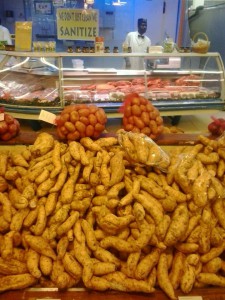

Agricultural Biodiversity Weblog
Agrobiodiversity is crops, livestock, foodways, microbes, pollinators, wild relatives …


The World Urban Forum is taking place down in my home town this week. That I suppose was what provided at least part of the impetus for the United Nations Standing Committee on Nutrition (UNSCN) to issue a statement on the Nutrition Security of Urban Populations. Not to be outdone, FAO has a publication out too, Growing Greener Cities in Africa, touted as the “first status report on urban and peri-urban horticulture in Africa.” A cursory glance doesn’t reveal much on diversity in these documents, but this is an issue that’s always intrigued me. Could cities act as magnets for crop inter- and intraspecific diversity? After all, they have lots of micro-niches, and have been attracting people from all over for decades, who could have come with their seeds. Is it possible that varieties could still be grown in cities after they’ve disappeared in their native areas? Or at any rate that crop diversity in a city is higher than in the surrounding countryside? Sometime ago we did a small survey of sweet potato diversity in Nairobi roadside verges that seemed to suggest that the menu of varieties was at least somewhat different from what was available in nearby rural areas. Should write that up one day. Anybody know of similar studies?
Yeah, summer is over and I’m back at work. Maybe you noticed I haven’t contributed much here in the past month or so. Or maybe you didn’t. Jeremy kept up a steady stream of agrobiodiversity nuggets pretty much all through August. But my lack of activity on the blog doesn’t mean I haven’t tried to keep up, as you would know if you followed us on Facebook, Twitter or Scoop.it. Anyway, for those that don’t, and would like to catch up on my summer reading, here is, in nibble form, what caught my eye during the past month or so:
I’m a little late to the warm beer and stale sandwich that is Plant genetic resources for food and agriculture: roles and research priorities in the European Union. This report, issued by the European Academies Science Advisory Council, “draws on” a workshop organised by the Italian Accademia Nazionale dei Lincei and sets out to identify key priorities for research areas. Naturally these require support funding.
Success in tackling these research areas requires increased policy commitment to co-ordinated and sustained EU-wide programmes and improved collaboration between the relevant scientific disciplines (including genetics and genomics, plant sciences, ecology, social sciences). In addition there must be improved linkage between all the activities inherent in plant conservation, research and breeding and improved use of the scientific evidence to inform strategic development for agriculture and land use.
Bring it on, obviously.
That said, the report does seem to have had its sights set so firmly on high that it doesn’t have a lot to say for the small growers and gardeners that Europe generally tramples underfoot. For example, the report namechecks “On-farm managed diversity” and “Links between conservation and use” and has an informative section of genetic erosion. And yet, when it comes to “Constraints on use” there is no mention of the single biggest constraint in Europe: European legislation. The report does say:
In Europe, genetic erosion associated with the introduction of deliberately bred cultivars has been significant for many crops.
It doesn’t say that if you don’t want to grow the specific deliberately-bred varieties Europe lists as acceptable, you’re mostly out of luck. 1
That’s not to do the effort down completely. There are some good summaries of what plant genetic resources for food and agriculture are all about, and their role in plant breeding, climate change and so on. The summaries of access and benefit sharing, and an overview of the European scene for PGRFA are worthwhile too.
In fact, as reference document, this report is pretty handy. It could, however, have issued a clear call to open up Europe’s seed markets to genuine diversity.
I wonder why it didn’t.